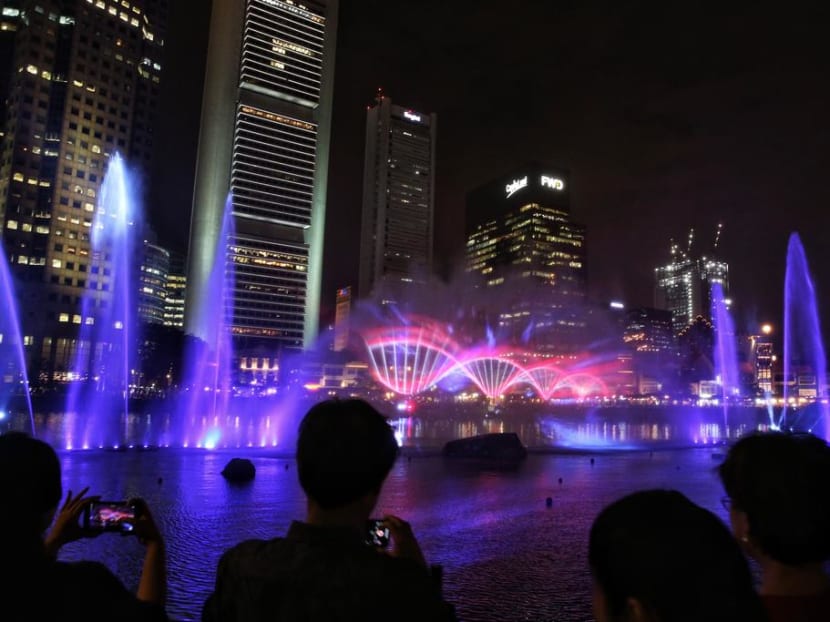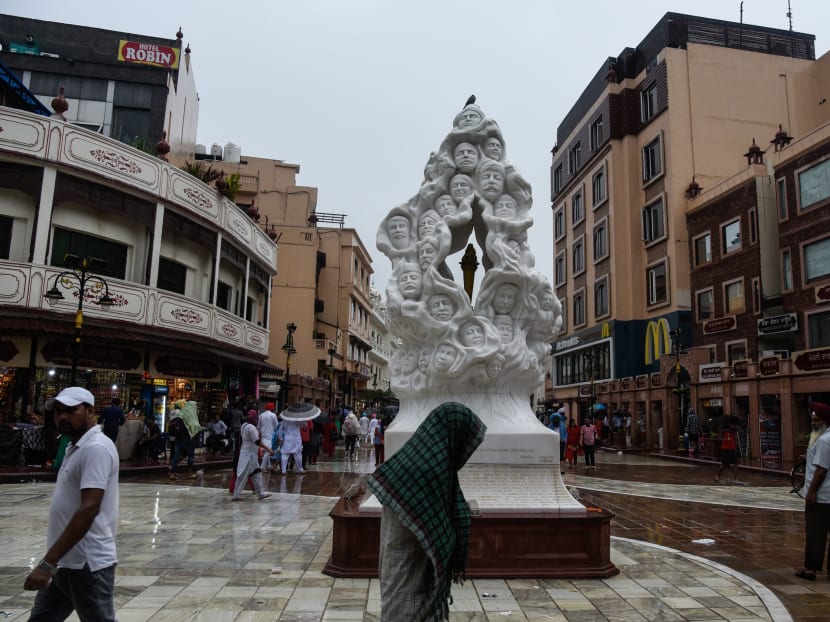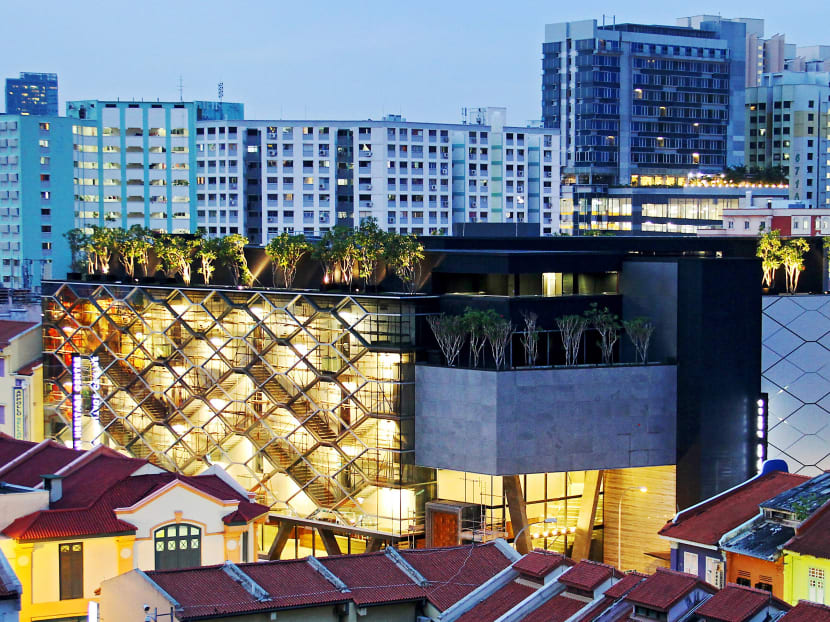Remembering Singapore’s India connection
I recently had lunch under the glare of a mass murderer. It was in a restaurant in a luxury hotel in Singapore. The restaurant’s theme was the British Empire and its décor sought to evoke a sense of nostalgia about colonial times.

A crowd watching a multimedia show at the Singapore River during the launch of the Singapore Bicentennial on Jan 28, 2019.
I recently had lunch under the glare of a mass murderer. It was in a restaurant in a luxury hotel in Singapore.
The restaurant’s theme was the British Empire and its décor sought to evoke a sense of nostalgia about colonial times. The food and service were very good, and I have no complaints there.
It was only at the end of the meal that I noticed a framed photograph of a British officer staring down at the diners. It was a photo of Brigadier-General Reginald Dyer, otherwise known as the “Butcher of Amritsar”.
To the hotel’s credit, it took down the photo immediately when I pointed this out.
For those who do not remember, while Singapore was celebrating its centenary in 1919, Dyer perpetrated the infamous Amritsar massacre on April 13, 1919 in the Jallianwala Bagh historic garden.
If one visits Amritsar one will find a memorial to the over 300 civilians — men, women and children — who were killed when Dyer ordered his troops to fire on a peaceful gathering of Indians.
According to Encyclopedia Britannica, a further 1,200 were wounded.
Dyer was unapologetic. In his own words: “It was no longer a question of merely dispersing the crowds but one of producing a sufficient moral effect, from a military point of view, not only on those who were present but more specifically throughout the Punjab.”
Lest anyone be under any illusions about the benign nature of British colonialism, Dyer’s actions were applauded by the white community in India.
In contrast, the massacre of unarmed civilians provoked a storm among non-whites.
Nobel Laureate Rabindranath Tagore renounced his knighthood in protest. Mahatma Gandhi launched his first non-cooperation movement.
The Amritsar Massacre pushed India towards independence and the dismantling of the Raj as Indians realised that the continuance of British rule was predicated not on any supposed moral superiority but on the threat and actual use of deadly force, even against unarmed British subjects.
The Straits Times in Singapore, then run by whites, published an editorial on May 31, 1920 supporting what Dyer had done. Its view was that his actions had saved the white community from slaughter.
This is unsurprising, given that there had been a mutiny in Singapore by the 5th Light Infantry in 1915 (the subject of a recent book by Umej Bhatia, “Our Name is Mutiny”). The British were always afraid that their subjects would rise up against them.
All this has been forgotten in Singapore a century on.

During our bicentennial celebrations (as with the centennial celebrations in 1919), much of the focus has been on the British. Yet Singapore’s connection to India goes right back to the foundation of the modern city.
Every school child knows that modern Singapore was founded by Sir Stamford Raffles in 1819, when he installed Tenku Hussein Shah as Sultan of Johore and later induced him to cede the island to the British.
What many do not recall is that in 1826 Singapore, Malacca and Penang were joined together in the Straits Settlements, as a Presidency of India.
The Settlements were transferred to the direct control of the Governor-General of India in 1851.
It was only in 1867 that the direct link with India was broken, when the Straits Settlements became a Crown Colony.
It was during the time when Singapore was part of India that the Indian Mutiny (also known as the First War of Independence) broke out in 1857. This was put down with great ferocity.
Thereafter, the spectre of such a rising haunted the British, not only in India but also in Singapore. British heroes of the Mutiny are commemorated by street names like Outram Road and Havelock Road.
The Singapore connection with India did not end in 1867. Resistance to British rule continued, not only in India but also among the Indian diaspora.
Some, like Gandhi, advocated non-violent resistance. Others, like Subhas Chandra Bose, preferred more direct methods.
Bose was detained by the British at the outbreak of World War II. He escaped, made his way to Germany and was instrumental in forming the Free India Legion (Azad Hind Fauj) from Indian prisoners of war in February 1942.
Meanwhile, on Feb 15, 1942, the Japanese administered the biggest drubbing ever to have been meted out to a British army when they took Singapore.
Later that February, over 25,000 Indian prisoners of war volunteered for the Indian National Army at a meeting in Farrer Park.
Bose was taken by German U-Boot to rendezvous with a Japanese submarine in the Indian Ocean. He eventually found his way to Singapore via Tokyo.
There, in the Cathay Building, he declared the independence of India in October 1943.
Bose was of course anathema to the British and after the return of the King, anyone in Singapore who admitted to admiration for Bose risked prosecution. But Kolkata’s airport is named the Netaji Subhas Chandra Bose International Airport.
Interestingly, Amazon Prime Video has just launched a mini-series titled “The Forgotten Army (Azaadi Ke Liye)”.
In the first episode a young Indian Singaporean, who knows nothing of Singapore’s connection to India, grumbles at having to give up his room to the “weirdo” brother of his dying grandmother.
After talking to the old man and doing some research, he discovers the part that Singapore played in Indian history during the war.
He then shows his visitor the Indian National Army Memorial on the Esplanade. This triggers off the old soldier’s recollections of his days fighting the British as a member of the INA.
How many Singaporeans today are ignorant about all of this, like the young man in the Amazon mini-series? It is time to address this historical amnesia.
People of Indian descent form 9 per cent of our population. The link to India is part of our national heritage.
It is ironic that running right next to the Indian Heritage Centre is Clive Street.
It was named after Robert Clive, who led the East India Company’s army to defeat the Nawab of Bengal in the Battle of Plassey in 1757, setting the stage for the subsequent British Raj in India. Clive Street may perhaps be renamed.

My suggestion: Call it the Rani of Jhansi Street. Rani Lakshmibhai was one of the leaders of the mutiny, having been dispossessed by the British who refused to recognise her as heir to the late Maharaja and annexed her state.
There is a Singapore connection to the Rani of Jhansi.
When Bose reinvigorated the Indian National Army in 1943, he instigated the formation of an all-women unit in Singapore – the Rani of Jhansi Regiment (documented by Joyce Lebra in her book “Women Against the Raj”). It was commanded by Dr Lakshmi Swaminadhan.
The personnel of the regiment (mainly Tamils) were recruited from British Malaya, including Singapore.
Some may say: “Nothing to do with me, I’m not Indian”. That would be unfortunate and inimical to societal cohesion.
Our shared history cannot be seen through a narrow ethnic lens.
The Ranis are as much a part of Singapore’s history as Major-General Lim Bo Seng (whose rank was posthumously awarded by the Republic of China, for whom he fought in her struggle against Japan) and Second-Lieutenant Adnan Saidi (a member of the Malay Regiment fighting to keep Malaya and Singapore in the British Empire).
A knowledge of where we came from is vital in appreciating what we are today and understanding where we should be heading in future.
A final footnote. In 1983, while in England, I watched the United Kingdom general election in which Mrs Margaret Thatcher won a resounding victory.
Last year I was again in England and watched the UK general election in which Mr Boris Johnson won another resounding victory.
What struck me was the difference in the media personalities who covered the election. Back in 1983, the presenters and commentators were uniformly white.
In 2019, a significant proportion were of South Asian ethnicity.
Mrs Thatcher’s cabinet was overwhelmingly white. Mr Johnson’s cabinet has three members of Indian ethnic origin (one born in Agra).
If in 1919 British society was as accepting of other races, instead of honouring war criminals like Reginald Dyer, they might still have an empire.
ABOUT THE AUTHOR:
Walter Woon was formerly Attorney-General of Singapore and currently the David Marshall Professor of Law at the National University of Singapore. He is the author of The Advocate’s Devil Quartet, a series of four historical novels set in Singapore from 1937 to 1945.






